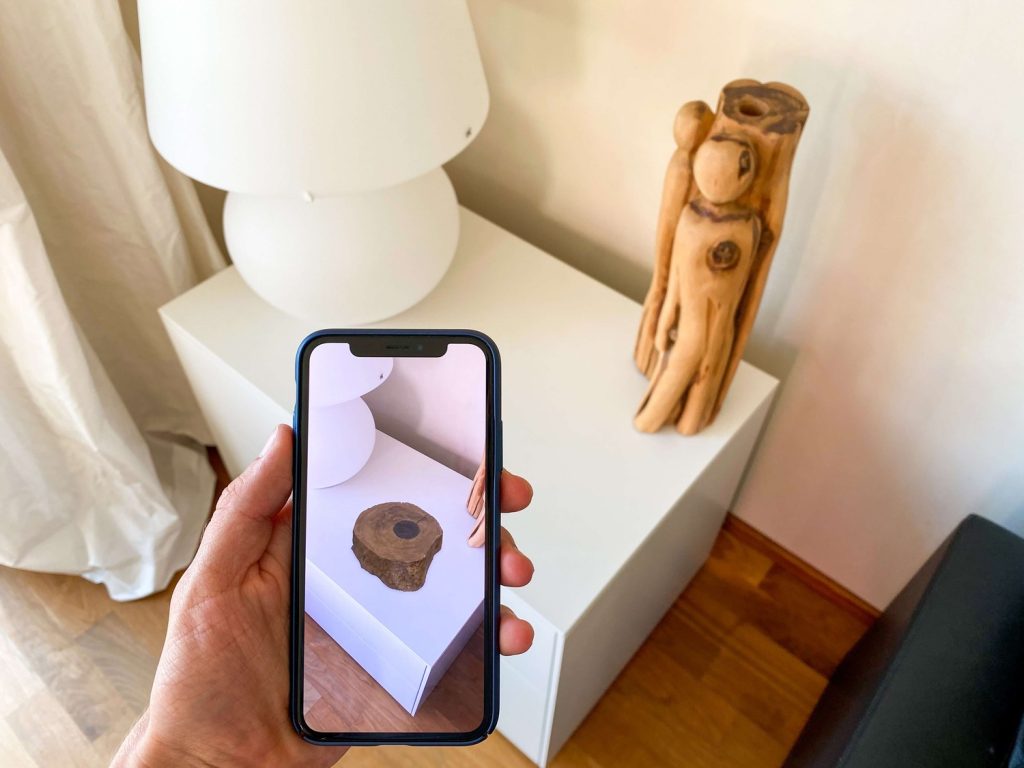The integration of augmented reality in eCommerce has emerged as a compelling solution to bridge the divide between in-person and online shopping experiences. By allowing customers to virtually visualize and interact with products as if they were physically in a store, it has brought forth a new era for eCommerce businesses.
AR technology has already made a significant impact, changing the way customers shop for a wide range of products, from fashion to interior design. With AR, customers can see how products would look in their homes or on their bodies, providing them with a more immersive and personalized shopping experience.
Let’s explore the significance of AR technology, namely:
- Why it matters
- Augmented reality vs. virtual reality: what sets them apart?
- AR and eCommerce: a perfect match
- A breakdown of augmented reality types
- Comparing WebAR and App-Based augmented reality
- Augmented reality: the next step in eCommerce evolution
- Exploring the use of AR in eCommerce
- AR for eCommerce: find out how your business can benefit
- Augmented reality in eCommerce: an inseparable future
AR: a force to be reckoned with an accelerating trajectory
To highlight the transformative potential of augmented reality, let’s consider some facts:
- The growth of AR usage is following the trend of increasing mobile usage – it’s expected that by 2025, almost all smartphone users and nearly 75% of the world’s population will be regular AR users.
- Businesses should be aware that incorporating AR experiences into products can lead to a remarkable 94% increase in conversion rates in some scenarios.
- According to recent studies, 76% of people desire to use AR as a practical tool in their day-to-day lives.
- According to data, a staggering 92% of Generation Z individuals express keen interest in using AR for shopping. This indicates that younger consumers are poised to spearhead the widespread adoption of the technology.
The main takeaway? Augmented reality is rapidly gaining popularity thanks to the widespread adoption of smartphones and the unique experiences it offers. As customer expectations continue to evolve, eCommerce businesses must evaluate how they can leverage AR to stay relevant and competitive in the market.

Augmented reality vs. virtual reality: what sets them apart?
In many cases, AR and VR are mentioned together as AR/VR, suggesting a common technological trend. However, while both platforms provide an immersive experience for users, they differ significantly.
- Augmented Reality – AR – superimposes digital content onto physical objects using cameras on smart devices and headsets.
- Virtual Reality – VR – on the other hand, completely immerses users in a unique virtual world through the use of headsets.
One way to think about the difference is that VR is like stepping into a different world, while AR is like having a digital overlay on top of the world you’re already in. AR can be used to provide additional information, enhance learning experiences, or create new forms of entertainment. Meanwhile, VR can be used for everything from training simulations to immersive gaming and storytelling.
Both VR and AR are powerful technologies that have made significant progress with consumers and still have a lot of untapped potential. However, in terms of eCommerce, AR is currently a more accessible way to enhance customer experiences, as it usually only requires a smartphone and doesn’t call for special headsets.
If you want to explore the intricate differences between AR and VR, check out our blog post.
AR and eCommerce: a perfect match
So, what are the key AR features that can contribute to its success in eCommerce?
In essence, AR and eCommerce have emerged as a perfect match, enabling online retailers to create an immersive and personalized shopping experience for their customers. AR technology bridges the gap between the physical and digital worlds, allowing customers to visualize products as if they were present in a physical store.
With the help of AR, customers can virtually try on clothes and accessories, visualize how furniture and home decor would look in their living spaces, and preview the features of products such as electronics and appliances. Augmented technology can improve the shopping experience for customers and enable them to make more informed purchasing decisions.

A breakdown of augmented reality types
To gain a better understanding of AR, it’s valuable to examine its various types, which can be grouped based on the trigger that initiates the AR experience. These types include marker-based, markerless, and GPS-based solutions, each with its own advantages and disadvantages.
Marker-based AR
Marker-based AR relies on a designated marker, such as a QR code, logo, or product packaging, to trigger the AR experience. The digital elements’ placement is tied to the marker’s position, and they move along with the marker as it rotates or shifts.
For example, incorporating AR features into kids’ clothing can provide a delightful and imaginative way to entertain children. With Overlyapp, users have the creative freedom to design their own unique shirts, resulting in personalized experiences without needing professional designers.
Markerless AR
Markerless AR, in contrast, doesn’t require a marker – users can launch it by selecting the AR feature in an app or clicking a link. It scans the real environment and places digital elements on a recognizable feature (like a flat surface) using geometry. It’s commonly used in gaming, live events, and virtual product placement.
For example, markerless AR enables the display of various items in 3D, providing an immersive “see and try before you buy” option for customers. Big names such as Amazon, Wayfair, Walmart, Made.com, and Alibaba are using this technology to enhance the shopping experience, allowing customers to virtually experience items before making a purchase.
But it’s not just big brands that can benefit from AR. Overlyapp partnered with Elpo – a company that invented a special air purifier but faced delivery challenges due to its size. They used AR for a virtual demo, allowing customers to experience the product in their own spaces before purchasing.
GPS or location-based AR
GPS based AR uses the sensors of the user’s mobile device to determine their location and create a corresponding AR experience. This is particularly useful in creating AR content that is location-specific, like providing information about landmarks or historical sites. In this type of AR, digital objects can be placed in a specific location, and as long as the user has the corresponding app installed, they can access the AR experience.
For example, Google Maps AR empowers users with augmented reality for navigation while walking. By using the rear camera of the phone to identify the user’s location, it overlays directions and details on the display – offering a more immersive experience than a standard map
Each type of AR has its advantages and disadvantages, and the choice of which method to use ultimately depends on the specific use case and desired outcome of the AR experience. We’ve got a blog post that covers the topic in more depth.
Comparing WebAR and App-Based augmented reality
There is also an important difference in terms of how AR can be accessed. WebAR allows users to access AR experiences directly from a mobile browser without the need to download a mobile app. In contrast, app-based AR requires users to download a specific mobile app to access AR experiences.
- App-based AR has the edge over web-based augmented reality in terms of its capabilities, as it can leverage advanced features to create diverse experiences. The integration of Apple ARKit and Google ARCore enables app-based AR to deliver superior performance and high-quality interactivity. However, convincing users to download the app remains a challenge for app-based AR, as it involves a data-intensive process that some users may find inconvenient.
- Web AR provides a hassle-free experience for users as there are no extra steps required to access it. Users can effortlessly engage with AR content by, for example, scanning a QR code that directs them to an AR-enabled website. The convenience of using Web AR can lead to higher engagement and interest from users, making it a great choice for businesses seeking a consistent experience across different platforms. While often lacking in advanced features compared to app-based AR, Web AR makes up for it with its ease of use.
Ultimately, the decision between app-based and web-based AR depends on the specific use case. Some AR experiences may require the advanced features offered by app-based AR, while others may be adequately served by more modest web-based AR options. If you are interested, our blog post provides a more in-depth exploration of this topic.
Augmented reality: the next step in eCommerce evolution
eCommerce businesses need to recognize that AR represents the next stage in the evolution of online retail.
Just like “shopping online” was once a revolutionary concept that quickly gained widespread acceptance, AR is also following a similar path. AR has already demonstrated its ability to meet customers’ desire for a more immersive and captivating shopping experience, despite being a relatively recent trend. As such, AR represents a natural and necessary progression in the world of eCommerce.
AR provides several advantages for eCommerce retailers:
- AR increases customer engagement and satisfaction by providing a more interactive online shopping experience
- AR can reduce product return rates by offering customers a more accurate representation of products
- AR offers eCommerce retailers powerful means of distinguishing themselves from their competitors – especially those who may be slow to embrace AR technology
- AR can be a cost-effective marketing tool, as it allows them to showcase products in an innovative and interactive way
As the tech continues to evolve, we can expect an increasing number of eCommerce retailers to integrate AR into their business strategies, revolutionizing the online shopping experience in ways that we cannot yet imagine.
Exploring the use of AR in eCommerce
In order to demonstrate the capabilities and use cases of AR in the eCommerce industry, let’s explore some specific examples of how diverse companies are effectively implementing AR technology today.
Overlyapp enhances TopShop’s eCommerce customer experience
Overlyapp partnered with TopShop to improve their traditional catalog shopping experience. Through the integration of AR technology, potential buyers can now scan items of interest to access more information, video demos, and direct purchasing links.
The use of an AR app has not only increased online sales and opened up new digital marketing opportunities, but also transformed TopShop’s catalog buyers into digital consumers. Although flipping through the pages of a physical magazine can be enjoyable, it may sometimes feel like an outdated medium. By scanning desired items, users can now conveniently make purchases by following direct links to the retailer’s website – resulting in fewer lost customers for TopShop.
ASOS’ AR try-on feature fuses online and in-store shopping experiences
Online fashion retailer ASOS has introduced a feature called “See My Fit”. It allows customers to view up to 500 products per week on six diverse real-life models, providing them with a simulated view of how the garment would look on different body types. The technology behind “See My Fit” digitally maps each product onto the model, taking into account the size, cut, and fit of each garment.
As a result, customers can see how the product would look on someone with a similar body shape as theirs, providing a more realistic and engaging product presentation. By effectively bridging the gap between online shopping and in-store shopping, this feature provides customers with a better understanding of how the product would fit them before making a purchase – and thus also reduces the number of product returns.
Online giant Amazon proves that AR is rapidly becoming mainstream
Amazon, the world’s most popular eCommerce platform, has introduced a new feature powered by AR technology for smartphones. This feature, called Amazon AR View, allows shoppers to superimpose virtual products onto their real-world environment using their smartphones.
By using this feature, shoppers can place digital products in their homes and evaluate how well they fit in terms of size and color. Amazon AR View is accessible through the Amazon smartphone app for both iPhone and Android users.
Amazon’s decision to integrate AR technology into its eCommerce platform clearly indicates that the technology is gaining mainstream acceptance. This suggests that in the near future, customers will likely consider AR to be a standard feature that is expected as part of their overall eCommerce experience.
AR for eCommerce: find out how your business can benefit
Despite the fast-paced development of AR, some eCommerce businesses may not be confident in their ability to use it effectively and incorporate it into their business model. In light of this, let’s delve into a guide that outlines the step-by-step process of identifying and implementing the potential benefits of AR for your eCommerce business.
Step 1: Identify your eCommerce business needs
The first step in determining how AR can benefit your eCommerce business is identifying your specific needs. Consider the challenges you currently face and how AR could help solve them. For instance, if your business experiences a high rate of product returns due to customers being dissatisfied with the product’s size or appearance, AR technology could enable customers to preview products interactively – thus reducing the likelihood of returns.
Step 2: Study your target audience
The next step is to study your target audience and their preferences. AR experiences can be tailored to different demographics, and understanding your audience’s preferences is essential in designing an effective AR experience. Conduct market research to determine which AR features would appeal to your customers and what AR features your competitors offer.
For example, younger generations tend to be more accustomed to AR technology, making them a potential target audience that certain eCommerce businesses can engage with more effectively.
Step 3: Identify the appropriate AR solution
After identifying your eCommerce business needs and studying your target audience, it’s time to evaluate the available AR technology options. There are several AR solutions available, ranging from web-based AR to in-app AR experiences.
Consider which solution would best fit your business model and budget. For example, Overlyapp offers a user-friendly AR building tool that enables eCommerce businesses to create both app-based and Web AR content experiences without requiring any coding skills. This allows them to explore the potential of AR without facing technical barriers.
Step 4: Create a comprehensive AR strategy
The next step is to devise an effective AR strategy. The most critical aspect of this process is determining the content that will be featured in the AR experience. This can include product information, images, videos, and other interactive elements that enhance the customer’s engagement with the product.
After deciding on the type of AR experience to use, the next step is to market it effectively to the target audience. Strategies such as leveraging social media platforms, email marketing, or targeted advertising campaigns can help generate interest and excitement among customers. The ultimate goal is to create a buzz around the newly available AR experience.
Step 5: Test and evaluate your AR experience
Once the AR experience has been developed, it’s essential to test and evaluate its effectiveness. Conduct user testing to determine if the AR experience meets the needs of your customers and if it enhances the overall shopping experience. Utilizing analytics can provide valuable insights into the effectiveness of the AR experience.
By tracking engagement metrics and conversion rates, you can gain a better understanding of how customers interact with the AR experience and how it impacts their purchase decisions. This data can help you optimize the AR experience to enhance its effectiveness and drive sales.

Augmented reality in eCommerce: an inseparable future
The rise of eCommerce has revolutionized the way people shop, making it more convenient than ever before. For many, shopping now means shopping online from the comfort of their own homes. Now, augmented reality in eCommerce has brought about another revolutionary transformation in the retail industry.
As the tech continues to evolve and become more accessible, it’s clear that the future of eCommerce is inseparable from augmented reality. As more and more retailers incorporate AR into their eCommerce strategies, it’s becoming increasingly clear that AR-powered eCommerce is here to stay.
In the near future, customers will likely expect AR to be a standard feature of their online shopping experience. However, at the moment, these features are still perceived as new and unconventional, and we have yet to reach a tipping point where they become ubiquitous.
This presents a valuable opportunity for eCommerce businesses to distinguish themselves from competitors and establish a unique brand identity in the crowded online retail market by incorporating augmented reality experiences.